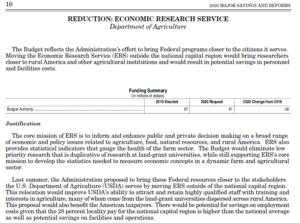As I noted earlier, Congress passed the 2018 Farm Bill without gutting SNAP but President Trump exacted a price for signing it—making it harder for States to exempt participants from work requirements.
The USDA released its new work-requirement rules just as Congress was passing the bill (here is the USDA’s quick Infographic summary).
As Politico put it, “USDA unveils crackdown on SNAP waivers.”
In his Orwellian press release, USDA Secretary Purdue said the new rules are:
intended to move more able-bodied recipients of Supplemental Nutrition Assistance Program (SNAP) benefits to self-sufficiency through the dignity of work. The rule is meant to restore the system to what it was meant to be: assistance through difficult times, not lifelong dependency…Long-term reliance on government assistance has never been part of the American dream.
In an even more Orwellian op-ed, Purdue said:
This restores the dignity of work to a sizeable segment of our population, while it is also respectful of the taxpayers who fund the program.
Americans are generous people who believe it is their responsibility to help their fellow citizens when they encounter a difficult stretch. That is the commitment behind SNAP. But like other Federal welfare programs, it was never intended to be a way of life. A central theme of the Trump administration has been to expand prosperity for all Americans, which includes helping people lift themselves out of pervasive poverty.
Trump’s statement outdoes anything Orwell could have imagined:
Today’s action will help Americans transition from welfare to gainful employment, strengthening families and uplifting communities…That was a difficult thing to get done, but the farmers wanted it done. We all wanted it done. I think, in the end, it’s going to make a lot of people very happy.
Why Orwellian?
Farmers? Strengthening families? Uplifting communities? Making people happy? Trump has to be kidding.
The true purpose of the new requirements is to reduce SNAP enrollment, never mind that most people who participate in SNAP really need it. The USDA says the new policy will 755,000 people out of the current 39 million.
Under current SNAP rules, adults who can work (able-bodied adults without dependents— ABAWDs) must work or be in training at least 80 hours per month. Otherwise they are only allowed to get SNAP benefits for up to three months in a three-year period.
But states can apply for waivers of this time limit, and 36 states have done so.
One reality check: Because the USDA does not keep data on food stamp recipients who participate in state employment and training programs, or on whether such programs do anything useful to help SNAP recipients achieve self-sufficiency, there is no way to know whether the new requirements will do any good.
I’m not the only one saying so. The Government Accountability Office has just issued a report making precisely this point.
As the Center on Budget and Policy Priorities explains:
Taking essential benefits like food benefits away from those who are unemployed wouldn’t address the inequities in the labor market or the challenges that so many workers face. Instead of punishing struggling workers, policymakers should support them through ideas with bipartisan support, such as a higher minimum wage, a stronger Earned Income Tax Credit, and paid family leave.
Maybe someday.



